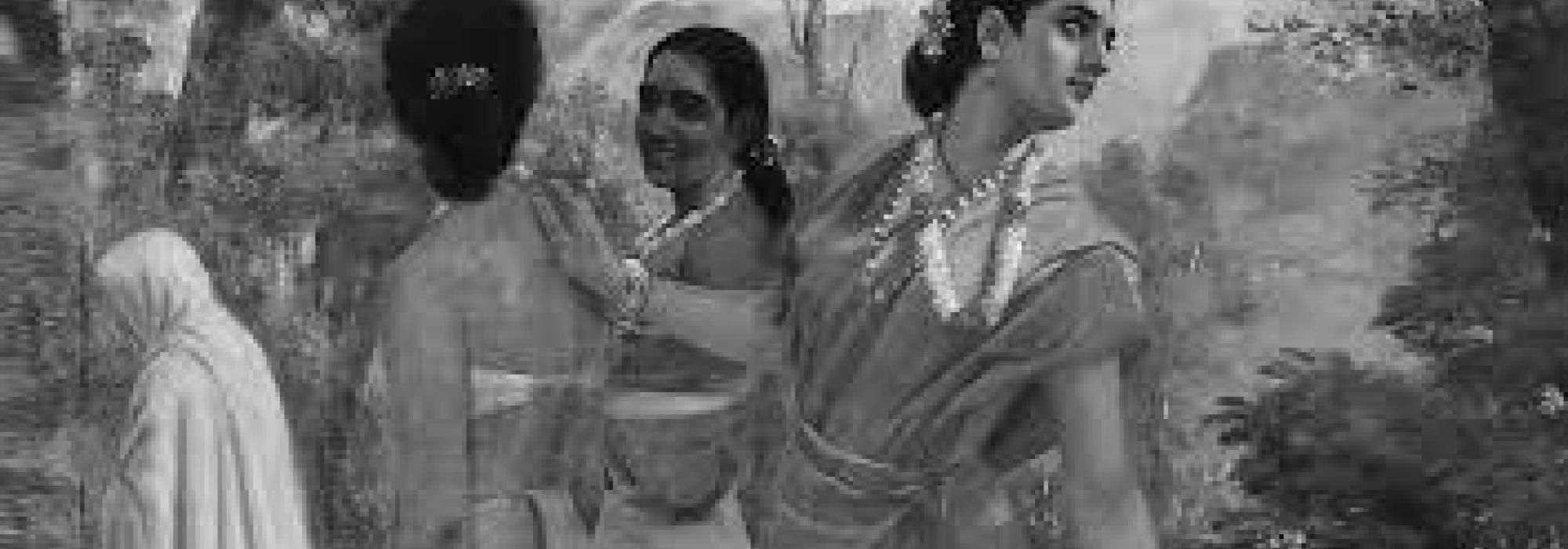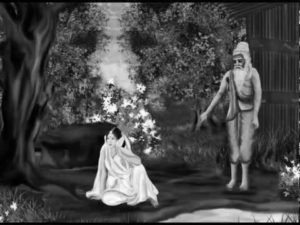Plot:
Aristotle holds the plot as the primary principle and the soul of tragedy, while character is secondary. Drawing parallels with a painting, he says, if one were to cover a surface randomly even with the finest colours, one would provide less pleasure than by an outline of a picture. (7: 1-5). Thus, rather than the choice of colours, it is what is done with the colours, what picture is painted and how elevating the picture is in its content matter the most. A plot is a structure of incidents, that are, like individual colours, blended to form the play-painting. A person who has read the Śākuntalam will see that Kālidāsa has made optimal use of his characters to suit the plot of the play. The focus is on developing sublime and elevating emotional situations, rather than an artificial effort to force-fit uber-human characters into a weak plot. Kālidāsa’s plot is his strength and it has all the key elements required by Aristotle – reversals, recognition, and suffering. It also qualifies as the ‘best’ kind of plot in its complexity, as it involves changes in the fortunes of the protagonist, who in this case is Śakuntalā. The plot arouses pity and it moves from good fortune to adversity, and also entails suffering for the protagonist. In addition to this, however, there is a second twist of fate that brings back good fortune to the protagonist and the play ends on a happy note. In the play, it is the good fortune of Śakuntalā that she finds a suitable companion for herself, and a potentially good fortune for Duṣyanta, as he can have the progeny of his clan through her. Through reversal of circumstances however, Śakuntalā is cursed and even loses the token of identity, the ring and undergoes a lot of suffering, being rejected by Duṣyanta. He is worried too, for he has not fathered any children. The discovery of the ring in a fish’s belly is again a twist of fortune and the ultimate fortune is Duṣyanta’s encounter with his son Bharata, along with Śakuntalā in Mārīca’s āśrama.
Character:
Closely following the importance of plot is the significance of character, according to Aristotle. Character is that which reveals moral choice- that is, when otherwise unclear, what kinds of thing an agent chooses or rejects (7: 5-10). Characterisation appears when (as said earlier) speech or action reveals the nature of a moral choice; and good character when the choice is good. Good character exists in each class of person: there is a good woman and good slave, even if the first of these is an inferior class, the other wholly paltry. The second aim is appropriateness: there is courage of character, but it is inappropriate for a woman (generally) to be courageous or clever in this way (15:16-22)
There are several instances where agents such as Duṣyanta and Kaṇva take morally right decisions and display good character through speech and action as required by Aristotle. Their behavior is also appropriate to their role. This appropriateness is called ‘aucitya’ in Indian aesthetics and Kālidāsa is known for his keen attention to aucitya. The following are a few instances that reveal Duṣyanta’s moral choice:
In the first act of the play, although Duṣyanta has been smitten by love for Śakuntalā, he restrains himself until he gets to know her background and her eligibility as a bride. Only after he hears from Śakuntalā’s friends Anasūyā and Priyamvadā that she is born to the Kṣatriya-sage Viśvāmitra and the apsara Menakā, does he deem it ethically right to even pursue his desire for her. He says to himself – “लब्धावकाशो मे मनोरथः” (my desire has now found scope; my desire can have a free rein). On further questioning, he discovers that her foster-father, Kaṇva is planning to give her away in marriage, and that is when his love actually finds expression. He says to himself –
भव हृदय साभिलाषं संप्रति सन्देहनिर्णयो जातः |
आकाङ्क्षसे यदग्निं तदिदं स्पर्शक्षमं रत्नम् || (1.24)
“Your wish may now be fulfilled, dear heart, away with doubts.
What you suspected to be fire, is indeed a gem capable of being touched.”
Thus, Duṣyanta even keeps his feelings for her well in check till he has satisfied himself that his love is not unethical and is directed towards a person of fitting characteristics, i.e., one who belongs to the same caste as the king by birth and is an eligible bride, in her father’s view too. His moral view and his responsibility as a king help him maintain resolve.
In the Fifth Act, when Śakuntalā comes along with her aides to his court, Duṣyanta does not even want to cast a curious glance at the lady who is covered with a veil, as he says “अनिर्वर्णनीयं परकलत्रम्” (It is improper to gaze at another’s wife).
In yet another instance in the Sixth Act, when he gets to hear that a merchant called Dhanamitra had died in an accident at sea, he makes sure that his wealth is dispersed to his family and to his wife, who is pregnant with child. He even says that Duṣyanta the king stands for the people who are orphaned by the demise of their relatives, and that he would be glad to take their place in a manner that is not sinful.
येन येन वियुज्यन्ते प्रजाः स्निग्धेन बन्धुना |
स स पापादृते तासां दुष्यन्त इति घुष्यताम् || (6.23)
In contrast to these, the poet shows what dereliction of a moral duty can lead to. Śakuntalā, who has lost herself in her thoughts about Duṣyanta, also forgets her duty as the care-taker of Kaṇva’s āśrama. Durvāsa, the guest, is enraged by her absent-mindedness and curses her –
विचिन्तयन्ती यमनन्यमानसा तपोधनं वेत्सि न मामुपस्थितम् |
स्मरिष्यति त्वां न स बोधितोऽपि सन्कथां प्रमत्तः प्रथमं कृतामिव || (4.1)
The fact that Śakuntalā’s behaviour during Durvāsa’s visit, although emotionally right, is morally wrong, is shown very well by the poet and this brings a total shift in the play.
Structure of a tragedy and length of its plot:
In Aristotle’s words, “Tragedy is mimesis of an action that is complete, whole, and of magnitude. A whole is that which has a beginning, middle and end. A beginning is that which does not itself follow necessarily from something else but after which a further event or process naturally occurs. An end, by contrast, is that which itself naturally occurs, whether necessarily or usually, after a preceding event, but need not be followed by anything else. A middle is that which both follows a preceding event and has further consequences. Well constructed plots, therefore, should neither begin nor end at an arbitrary point, but should make use of the patterns stated” (7:23-32)
The beginning of the play Śākuntalam does not assume any prior knowledge of events and does not start in medias-res (middle of things). It starts off as an independent event where Duṣyanta is out in the forest hunting and happens to come across Kaṇva’s āśrama. Thus, the play, as required by Aristotle, does not follow from something else but its early events logically give raise to the later ones. The play ends with Duṣyanta and Śakuntalā’s union along with their son and gives it a meaningful completion. The incidents in the middle follow each other and are aesthetically consistent.
Well constructed plots, should neither begin nor end at an arbitrary point. Besides, a beautiful object, whether an animal or anything else with a structure of parts, should have not only its parts ordered but also an appropriate magnitude: beauty consists in magnitude and order, which is why there could not be a beautiful animal which is either minuscule (as contemplation of it, occurring in an almost imperceptible moment, has no distinctness) or gigantic (as contemplation of it has no cohesion, but those who contemplate it lose a sense of unity and wholeness), say an animal a thousand miles long. So, just as with our bodies and with animals, beauty requires magnitude, but magnitude that allows coherent perception, likewise plots require length, but length that can be coherently remembered (7:35-40, 8:1-5). The size which permits a transformation to occur, in a probable or necessary sequence of events from adversity to prosperity or prosperity to adversity, is a sufficient limit of magnitude. (8:10-15)
The fact that the whole story of Śākuntalam has caught the imagination of people throughout the world, has stood the test of time and has a magnitude that is intense and comprehensible at the same time helps it qualify when evaluated using Aristotle’s yardsticks. Early twentieth century Indian scholars like AR Krishna Shastry [3], K Krishnamoorthy [4] and others [6], [7], [8] also show how the dimensions of the play are optimal.
Speaking of poor plots, Aristotle says – “Of simple plots and actions, the episodic are the worst. By ‘episodic’ I mean a plot in which the episodes follow one another without probability or necessity. Such plays are composed by bad poets through their own fault, and by good poets for the sake of the actors: for in composing show pieces, and stretching the plot beyond its capacity, they are often forced to distort the continuity” (10: 33-36).
To be continued..
















































